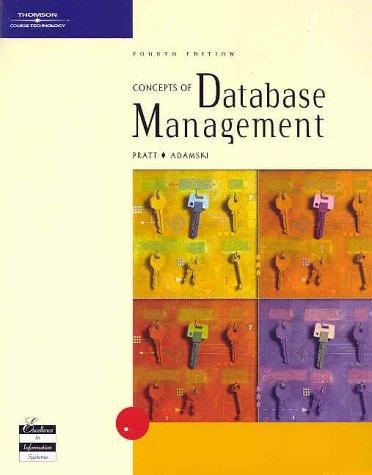Question
Discussion - Week 4 Classes Information systems are designed utilizing an object-oriented approach. The key to this is the idea of a class. A class
Discussion - Week 4
Classes
Information systems are designed utilizing an object-oriented approach.
The key to this is the idea of a class. A class gives a general template for collecting information about properties and for implementing methods. Then, specific instances of the class are created as objects. Classes are shown in unified modeling language (UML) class diagram notation.
Name of Class
| List of information needed for the class + variable1: type + variable2: type + variable3: type |
| List of programmed processes or methods the class can implement + method1 + method2 + method3 |
As an example from the Benchmarks, a human resources system requires an Employee class. This class would store employee information like name, department, pay rate, and time worked as properties of the class. The class methods would be able to perform tasks like calculating pay, raising pay rate, or changing name.
Employee
| + name: string + ID: string + department: string + pay_rate: decimal |
| + calculate_pay() + pay_rate_raise() + change_name() |
Each specific employee would be an object of the Employee class. For example, it is possible to create an Employee object called Jasmine storing specific information about Jasmine. A Visual Basic program call to do this might be:
Dim Jasmine as New Employee (Jasmine Reynolds, Z4327, art, 33.15)
Here are two additional UML class diagram examples. One is a human vitals class from a health care system. It would be a subclass under a Patient class. The other is a class to maintain registration information. It would be a subclass of a Student class. Try to think through these class specifications. What information does each store as properties? What does each method do? What would a specific object look like?
Vitals
| + temperature: decimal + pulse_rate: integer + systolic_pressure: integer + diastolic_pressure: integer + respiratory_rate: integer + oxygen_level: decimal |
| + measure_temperature() + measure_bloodpressure() + measure_respiration() + measure_oxygen() + monitor_temperature() + monitor _bloodpressure() + monitor _respiration() + monitor _oxygen() + monitor_all_vitals() + vitals_warning() |
Registration
| - registered_courses: array |
| + add_course() + drop_course() |
Now, it is your turn. Create your own UML class diagram for a class. You can choose any information systems application you like. Include the name of your class, the properties list including variable type, and the methods list. In addition, briefly describe the role of your class in the broader system.
Step by Step Solution
There are 3 Steps involved in it
Step: 1

Get Instant Access to Expert-Tailored Solutions
See step-by-step solutions with expert insights and AI powered tools for academic success
Step: 2

Step: 3

Ace Your Homework with AI
Get the answers you need in no time with our AI-driven, step-by-step assistance
Get Started


